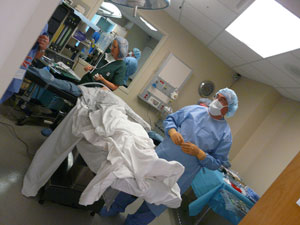Life or death: Medical packaging can make the difference, says AgBioResearch scientist
The seconds it takes to get a medical device to work properly or to understand the packaging on a device, can be a matter of life and death.
The seconds it takes to get a medical device to work properly or to understand the packaging on a device, whether at the site of a car crash, in an emergency room or at an operating table, can be a matter of life and death.
properly or to understand the packaging on a device, whether at the site of a car crash, in an emergency room or at an operating table, can be a matter of life and death.
To bridge the gaps between the people packaging medical equipment and the healthcare professionals using it, the Michigan State University (MSU) School of Packaging and its Learning and Assessment Center teamed up with a Grand Rapids firm to host the Healthcare Packaging Immersion Experience on Oct. 5-6. A similar pilot program took place in 2010.
MSU AgBioResearch scientist Laura Bix and Mary Kay Smith, director of the Learning and Assessment Center, worked with Oliver-Tolas Healthcare Packaging, a Grand Rapids producer of sterile-grade medical device packaging, for the event.
"Our goal is to provide a bridge between the people designing, manufacturing and packaging the devices and the real world," said Bix, an associate professor in the School of Packaging. "It's important to know how what you produce as a packaging engineer affects outcomes in the emergency, operating room or ambulance. This unique education experience showed medical device manufacturers what aspects they must consider when designing devices and their packages."
The event allowed senior-level medical device packaging professionals to experience the real-world performance of medical packaging in simulated operating and emergency rooms. Participants also discussed packaging challenges and possible solutions with nurses and doctors.
Smith said having participants experience simulated procedures occurring in realistic contexts can be extremely important.
"Packaging engineers and manufacturers are, generally speaking, not physicians or technicians in these environments," she said. "Simulations provide an opportunity to evaluate how devices work -- and don't -- in a safe environment. Ultimately, this can lead to better quality patient care."
MSU is the only university in the world to have colleges of Human Medicine, Nursing, Osteopathic Medicine and Veterinary Medicine and a School of Packaging, so it is logical for the institution to host the event, Bix said.
The featured speakers at the two-day event included Jim Bagian, a former NASA astronaut with more than 300 hours in space, who also served as the chief patient safety officer and director of the Veterans Affairs National Center for Patient Safety. He also specializes in snow and ice rescue and has served as a member of the Denali Medical Research Project on Mt. McKinley. He discussed his experiences with packaging in extreme contexts of use and the consequences that poor design can have on medical care.
Other highlights included sessions involving hands-on simulations from emergency rooms and accident scenes, in which audience members witnessed how a specific situation can significantly affect a user's abilities.
In addition to MSU and Oliver-Tolas Healthcare Packaging, the conference was sponsored by DuPont, Multivac, Glenroy Inc., Neenah Paper and Cardinal Health.
To view a video of the 2010 pilot event, visit http://www.youtube.com/watch?v=vWZa6bN8bWg.



 Print
Print Email
Email




